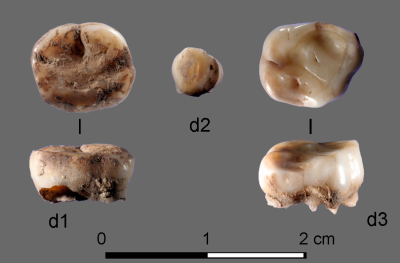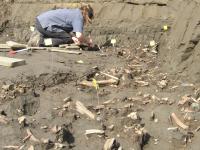DNA from the oldest known virus in humans found on two 31,600-year-old milk teeth from Siberia
Scientists from the University of Copenhagen have played a key role in piecing together the severely fragmented viral DNA. The virus in question may be as much as 700,000 years old – and it is still making people ill today.
When scientists encounter a real rogue of a virus that can make people sick – such as Covid – there are many things they will want to know about it. Such as: Where did it come from? How long has it been on the way? And when did it first attack human beings?
If the scientists can learn more about this, they will have a basis that may ultimately lead to a better understanding of how the virus works and attacks – which in turn can lead to good ideas about how to counteract the harmful effects of the microorganism on human beings.
But it’s a tough nut to crack, because if you try to trace a virus back in time, the trail quickly goes cold because DNA naturally degrades.
As a result, when researchers attempt to trace old DNA from viruses, bacteria or other pathogenic microorganisms in human samples such as tissue, hair or blood, scientists can generally only follow its path back in time to a limited extent – typically less than 100 years. This is because the older the sample, the more the DNA from the pathogenic microorganisms it once contained will have degraded – especially if the material has been in a warm and damp place.
There are exceptions, however – including to some extent bones, and in particular teeth, which in some cases can retain analysable viral and bacterial DNA for a very long time, because the enamel acts as a protective cover against the ravages of time.
And it is teeth, namely two milk teeth, that have now established a new world record: They turned out to conceal DNA from a pathogenic virus that was already rife and attacking human beings as far back as 31,600 years ago. The previous record for analysable DNA from a microorganism that can cause disease in humans was ‘only’ about 10,500 years: This involved DNA from hepatitis B that was recorded in two Stone Age skeletons – one in Russia and one in Belgium.
The discovery of the 31,600-year-old virus from Siberia has been published on the scientific portal ‘bioRxiv’, and the research project has been run by a group of scientists from Denmark, Russia, Australia, the UK and Sweden.
The entire investigation – in reality, a matter of assembling a giant jigsaw puzzle of ultra-small, highly fragmented pieces of DNA – has been led by scientists from the Lundbeck Foundation GeoGenetics Centre at the University of Copenhagen (KU).

The milk teeth
The story of the discovery of the 31,600-year-old virus began in 2017, when Sofie Holtsmark Nielsen was writing her PhD thesis.
Sofie is a bioinformatician who was at that time employed by the Lundbeck Foundation Geogenetics Centre, and in consultation with her PhD supervisor, Associate Professor Martin Sikora, she decided to take a closer look at the results of previous analyses of several thousand samples of old human DNA stored in special freezers at KU.
The idea was that she would search the sample printouts from these many studies for DNA profiles of microbes – and she set about doing just that.
One by one, she compared the printouts with the known DNA profiles of a wide range of micro-organisms that can make people ill, to see if these were present in the samples.
“It was a lot of work, but when I reached two milk teeth that had been found a few years earlier in an archaeological excavation of a settlement on the Yana River in northern Siberia, I struck gold,” she says.
The Yana excavation uncovered a wide range of cultural artefacts, including beautifully crafted tools made from the horns of prey animals. When the site’s oldest layers were dated, it was revealed that people settled here 31,600 years ago – and that they lived by hunting woolly mammoth and those species of rhinoceros that were present in the Siberian fauna of the time.
The oldest Yana layer, which had been protected by the permafrost, contained the only samples of human DNA found in the excavation: three milk teeth, two of which were later made available to the researchers at KU.
The two rootless teeth turned out to come from two boys – and the DNA in them was so well preserved that the researchers were able to obtain a complete picture of both boys’ genomes.
In the many DNA studies carried out by the scientists at KU, the teeth were ground up and partially pulverised, after which all the DNA they contained was recorded in a so-called sequencing process.
“This meant you could find the person’s own DNA, but in addition to that, also all the DNA from, for example, bacteria and viruses that was encapsulated in calcium deposits on the tooth or carried to the tooth via the person’s bloodstream,” explains Associate Professor Martin Sikora, who led the study, which has now been published via ‘bioRxiv’.
And it was viral DNA that Sofie Holtsmark-Nielsen discovered when she closely examined the sample printouts from the two milk teeth: namely human adenovirus C (of the types HAdV-C1 and HAdV-C2).
Today, human adenovirus C is a very common infection which typically occurs in the early years of life and can cause respiratory infections in young children.
When it became clear that human adenovirus C was present in the old samples, the next question was: How closely are the two old virus variants genetically related to the present ones?
To answer that question, it was necessary to reconstruct the genetic composition of the two ancient variants of the adenovirus, which lay scattered about in the mass of pulverised milk teeth, in the form of myriads of tiny DNA ‘puzzle pieces’.
The ultimate goal was to assemble complete genomes, i.e. the entire genome of the ancient adenoviruses, and compare them with modern versions of these viruses.
From the Neanderthals?
They succeeded in this to a sufficient extent, and somewhat surprisingly, the comparison showed that the old samples from Siberia and the modern versions of human adenovirus C were very similar. As Sofie Holtsmark Nielsen says:
“Adenovirus was first isolated in 1953, so the oldest samples of modern versions of the virus only date back about 70 years. When you look at the mutations that the virus has undergone in this short space of time, your immediate assumption might be that it’s a young virus. But it’s not.”
The 31,600-year-old samples from Siberia date from the Pleistocene geological period. This period stretches from 2.6 million years ago until the end of the last Ice Age, around 11,500 years ago, when the current period, the Holocene, began.
The team behind the scientific paper has attempted to estimate the age of human adenovirus C using an advanced mathematical model that can create a phylogenetic tree – a so-called evolutionary tree. This calculation suggests that the adenovirus may be up to 700,000 years old – in which case it may have originated among some of the early ancestors of the human lineage.
“One could well imagine that modern humans – Homo sapiens – originally got human adenovirus C from Neanderthals, because we know that there was gene-sharing between Homo sapiens and Neanderthals about 70,000 years ago,” says Sofie Holtsmark Nielsen.
There are a number of different adenoviruses; some attack animals, while others attack human beings.
Adenovirus was first isolated in 1953, and has been studied very intensively ever since.
Today, adenovirus is used in the manufacture of some vaccines as a so-called vector, i.e. as a kind of ‘lorry’ to transport the vaccine. The virus is also used for this purpose with certain COVID-19 vaccines, including the Astra Zeneca vaccine. However, this is not the case for the vaccines from Pfizer and Moderna that the Danish health authorities have chosen for their vaccination programme. The version of adenovirus used as the vector in COVID-19 vaccines is not identical to the adenovirus types found in the ancient milk teeth from Siberia.
Adenovirus is also used as a vector in gene therapy, to place certain properties in cells.
Finally, adenovirus is also used as a research tool when conducting experiments involving genetic manipulation.
